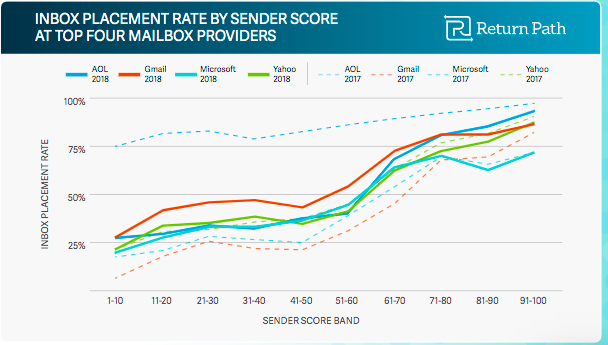
Much like with when conducting any interaction, reputation is important. When you are searching for a new restaurant to eat at or a new doctor to visit, looking up reviews helps you to choose where to go. Mailbox providers incorporate a similar tactic by evaluating the reputation of incoming senders to determine which messages to accept into their mailboxes.
Why is reputation important?
A mailbox providers job is to provide a quality email experience to their users or risk losing their customers to a competitor. This means delivering the messages they want and protecting them from the mail they don’t. To ensure they are filtering the right messages to the correct folders (inbox vs spam), mailbox providers rely on reputation calculations.
What influences sender reputation?
There are many different elements that can influence a senders reputation. In fact, each mailbox provider has their own unique reputation formula—which they, unfortunately, don’t disclose publicly. But while each calculation differs slightly, the elements they look at are all the same. Namely, anything that represents “spammy” behavior (complaints, spam traps, unknown users, blacklists, etc.,)
How does reputation impact deliverability?
In our recent study—the 2019 Sender Score Benchmark— we looked at the relationship between reputation and deliverability. We measured reputation using our own reputation calculation system—Sender Score.
Sender Score is a numerical score (from zero-100) for your IP address which operates much like a credit score. The higher the score the higher the reputation. It incorporates similar criteria that mailbox providers use in their own calculations to give senders an idea of how their program is being viewed.
The graph below shows the relationship between Sender Score reputation and deliverability at AOL, Gmail, Yahoo, and Microsoft. As you can see: as reputation increases, deliverability increases at all four mailbox providers.
How to strengthen and maintain your reputation.
Low reputation as a result of “spammy” behavior will see your messages blocked from the inbox. To build and maintain a strong reputation, try the following:
1. Monitor your reputation
Your sender reputation constantly changs as a result of your sending activities. It’s important to know if, when, and why your reputation declines so you can immediately address any issues and limit the impact on your program. Before you send a new campaign, look up your latest reputation score for free at senderscore.org to make sure your latest campaign will reach your subscribers before you send.
2. Keep your list clean
Spam traps, unknown users, and unengaged subscribers can have a detrimental impact on your email program. Ideally, you should run your list through a list hygiene service, which will validate whether the email address belongs to an active person. Alternatively, you can suppress and remove users who have not engaged with your email program within the last 60 days. This will help you identify addresses that could potentially harm your reputation.
3. Sign up for feedback loops
Having complaints can severely impact your reputation. Immediately address complaints by signing up for feedback loops. Each mailbox provider offers its own feedback loop service. Identify which ones are valuable to your program and how to sign up in our post: What is a Feedback Loop.
4. Identify where complaints are coming from
Reacting to complaints is only the first step. If you don’t know the cause, the rest of your subscribers are likely to issue their own complaints. By identifying where your complaints are coming from, you can discover what parts of your program need to be fixed to limit subscriber dissatisfaction.
5. Check for blacklisting
Mailbox providers include blacklisting in their filtering decisions, so it’s important to know immediately if you are blacklisted and where. Make sure you regularly check your IP address on a blacklist lookup.
